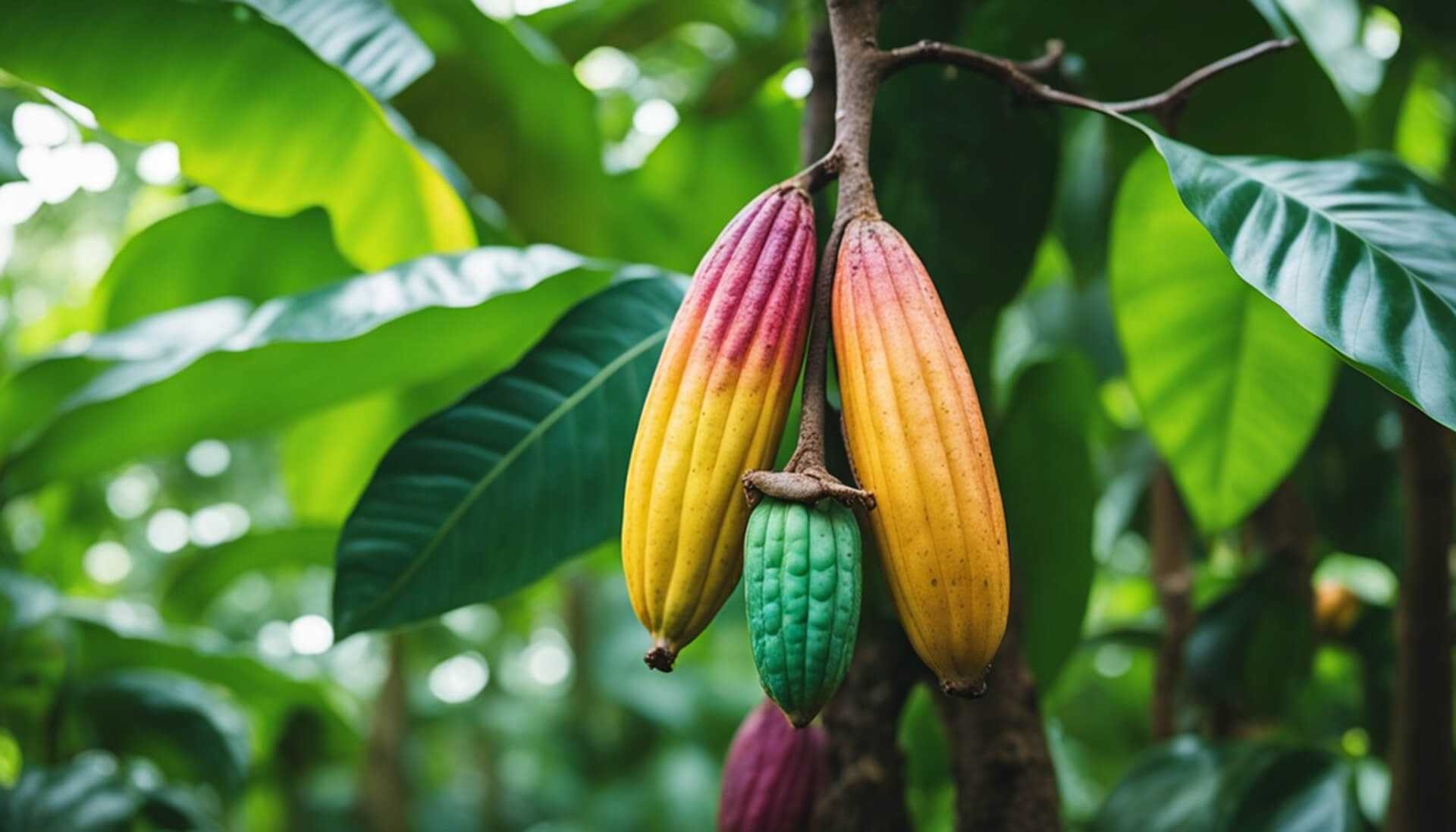Cacao and cocoa are often discussed interchangeably, but understanding their differences can help you make informed choices about your diet and treats.
Cacao is the raw, unprocessed form, rich in antioxidants and nutrients, while cocoa undergoes processing that reduces its nutritional value but makes it sweeter. This key distinction affects not only their health benefits but also their taste and uses in cooking.
Cacao is derived directly from cacao beans and maintains a more intense, bitter flavor that is ideal for health-conscious recipes.
Conversely, cocoa is processed and often mixed with sweeteners, making it more palatable in a variety of desserts.
When choosing between the two, your decision might hinge on whether you prioritize health benefits or taste.
By delving into this article, you’ll learn about the intricate process of transforming cacao beans into cacao and cocoa, exploring their unique health benefits, and discovering how to best use each in your kitchen.
The Basics of Cacao and Cocoa
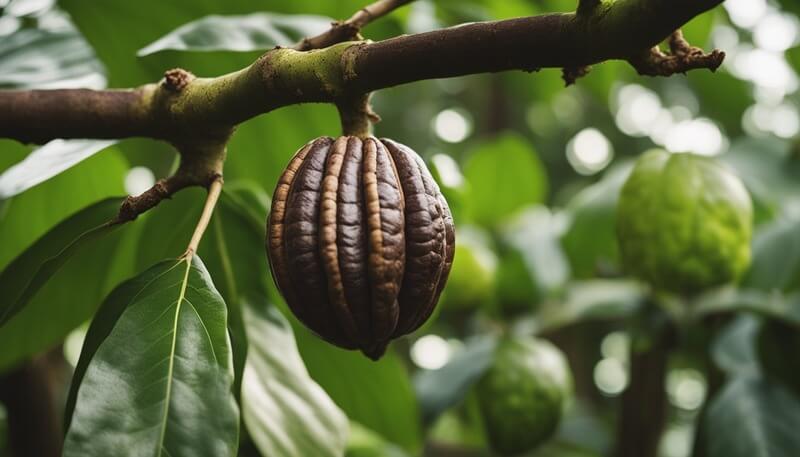
Cacao and cocoa come from the Theobroma cacao tree but are processed differently, leading to flavor, texture, and nutritional content variations. Understanding these differences can help you choose the right ingredients for your needs.
Definition and Origin
Cacao refers to the raw, unprocessed, or minimally processed beans harvested from the Theobroma cacao tree. Due to minimal heat exposure, cacao retains more nutritional value.
Cacao has a rich historical tradition, beginning with the Mayans and Aztecs, who valued it as both food and currency.
Spanish explorers later introduced it to Europe, where it evolved into what we know today.
Conversely, cocoa is derived from the same beans but undergoes more extensive processing and higher heat. This increases sweetness but reduces its nutritional content compared to cacao.
Cacao Beans and Their Processing
Cacao beans are found inside the large, football-shaped pods of the Theobroma cacao tree. These pods are harvested by hand and then cracked open to reveal the beans surrounded by a sweet, white pulp.
The beans undergo a fermentation process lasting several days, which helps develop their complex flavors.
Post-fermentation, the beans are dried, often under the sun.
This drying process preserves the beans’ nutritional content, producing higher antioxidants and other beneficial compounds.
Sometimes, raw cacao products are made with beans that have been fermented and dried but not roasted, retaining their raw status.
Cocoa Beans and Their Processing
Cocoa beans start their journey similarly, harvested from cacao pods.
However, these beans are roasted at higher temperatures after fermentation and drying.
Roasting alters the flavor, making it milder and sweeter. It also affects the nutritional profile, reducing some of the antioxidants in raw cacao.
Once roasted, the beans are ground into a paste called chocolate liquor. This paste is further processed to separate cocoa solids from cocoa butter.
The cocoa solids are then ground into a fine powder, which is commonly used in baking and chocolate products.
The contrast in processing methods between cacao and cocoa results in notable differences in flavor and nutritional profiles, making each suitable for different culinary applications.
Chemical Composition and Nutrient Content
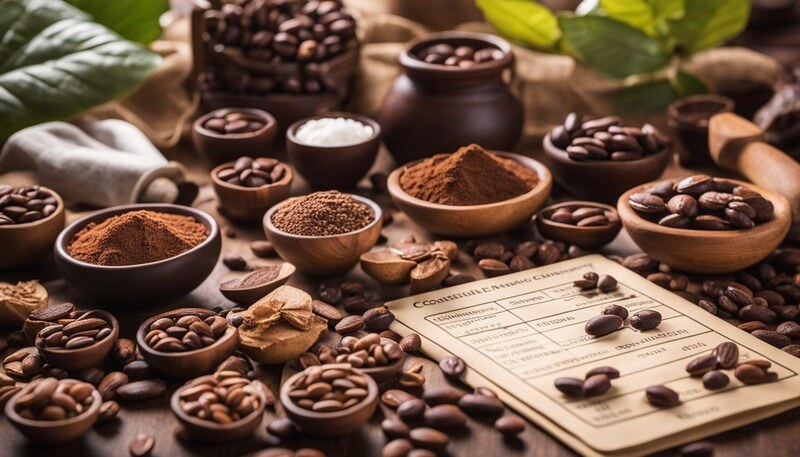
Cacao and cocoa come from the same plant but undergo different processes, leading to variations in their chemical makeup and nutritional value. Understanding this difference is key to understanding their distinct health benefits.
Cacao: Raw Nutritional Powerhouse
Cacao is rich in nutrients and bioactive compounds. It contains high levels of flavanols, which have potent antioxidant properties.
Flavanols help improve blood circulation and support heart health.
Cacao’s iron content is notable; according to Forbes Health, one serving provides 25% of the recommended daily allowance (RDA) for men and 11% for women.
Cacao also has significant amounts of fiber, which aids digestion and helps maintain healthy cholesterol levels.
It is a good source of several essential minerals, including magnesium, copper, and potassium, which support various bodily functions such as muscle and nerve function, immune system health, and blood pressure regulation.
Cocoa: Benefits Despite Processing
Cocoa powder from roasted cacao beans generally contains fewer flavanols due to the heat treatment but still offers several health benefits.
These include improved mood and cognitive function, attributed to the presence of natural stimulants like theobromine and caffeine.
Although the cacao’s nutrient profile changes during processing, cocoa remains a valuable source of antioxidants.
Cocoa retains much fiber and minerals, including iron and magnesium, in lesser quantities than raw cacao.
It has a milder flavor and is more versatile for baking and cooking, making it a popular choice in many recipes.
Despite the processing, cocoa continues to be a nutritious and beneficial ingredient.
From Bean to Bar: Production and Manufacturing
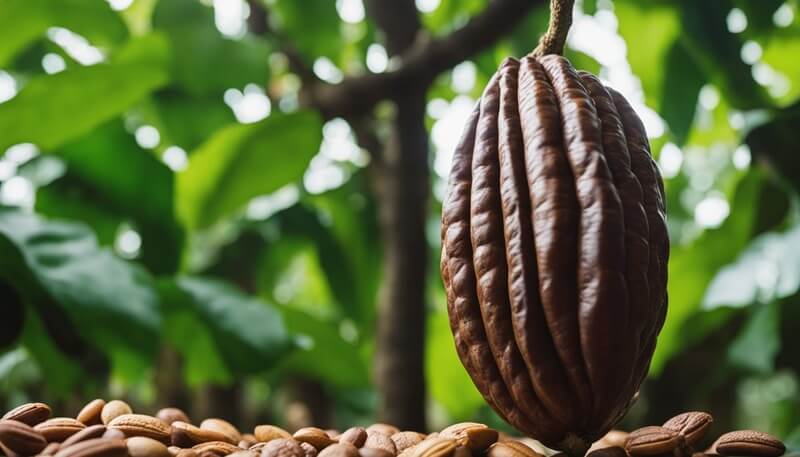
The journey of chocolate from cacao beans to delicious treats involves several key steps. Understanding these processes can help you appreciate the flavor, texture, and quality differences between various chocolate products.
Processing Steps
The production of chocolate starts with harvesting cacao beans. These beans initially taste bitter and must be fermented to develop their unique flavors. Fermentation usually takes place over five to seven days.
After fermentation, beans are spread out to dry. The drying process often takes place under the sun, which helps to stop fermentation and enhances storability.
Once dried, the beans are roasted to bring out their rich, complex flavors.
Next, the beans are winnowed to remove their shells, producing cacao nibs. The nibs are then ground into a thick chocolate liquor or cocoa mass paste. This can be further processed to separate cocoa solids and cocoa butter.
Converting Beans to Consumer Products
Once the cacao beans are processed into chocolate liquor, they can be made into various products like cocoa powder, cacao powder, and baking chocolate.
Chocolate liquor can be pressed to separate the cocoa butter from the cocoa solids. The solids are ground into cocoa powder and used in baking and drinking chocolates.
Dutch processing may be used for smoother, sweeter chocolates, like milk chocolate. This alkalizes the cocoa, removing acidity and bitterness.
Cacao nibs are often used raw in smoothies or as a topping for healthier snacks due to their less processed nature and higher nutrient content.
Differences and Similarities
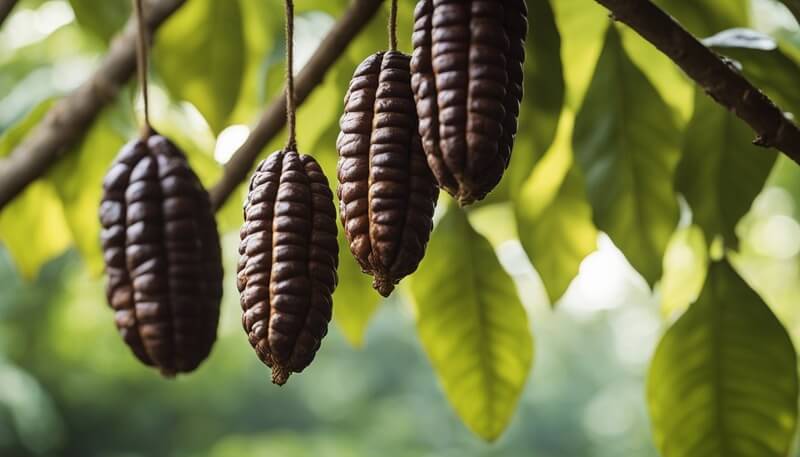
Cacao and cocoa differ significantly in processing, affecting their nutritional content and culinary uses. Cacao is less processed than cocoa, preserving more nutrients and antioxidants.
Nutritional and Health Comparisons
Cacao is considered a “superfood” because it retains more natural antioxidants and beneficial plant compounds due to minimal processing.
Cacao powder is rich in magnesium, iron, and potassium. An ounce of cacao powder contains about 130-140 calories.
It also has heart-protective and anti-cancer properties, making it popular among health-conscious consumers.
Conversely, Cocoa is processed at higher temperatures, which may reduce some of its nutrient content. However, it still provides a good source of iron and other minerals.
Cocoa powder is often used unsweetened for baking and is more accessible at grocery stores. While it may have fewer disease-fighting plant compounds than cacao, it still benefits health.
Taste, Usage, and Culinary Roles
Cacao and cocoa also differ in taste and culinary applications.
Cacao tastes more bitter and is often used in vegan foods, smoothies, and raw desserts.
Its strong flavor makes it a popular choice for those who prefer intense, natural chocolate flavors.
Cacao butter, extracted from cacao beans, is a common ingredient in chocolate bars and vegan cooking.
Being milder and less bitter, Cocoa is more suitable for baked goods like cakes, cookies, and brownies.
Cocoa powder is frequently used in baking because of its rich flavor and easy mixing with other ingredients.
Chocolate chips made from cocoa are a common addition to various desserts.
In comparison, cacao can sometimes be a substitute for cocoa, but the difference in taste and texture should be considered.
Culinary Applications and Recipes

Both cacao and cocoa are versatile ingredients in home and professional kitchens. They each bring unique flavors and nutritional benefits to various dishes and desserts, from hot chocolate to chocolate cake.
Home Cooking and Professional Use
In-home kitchens, cacao, and cocoa are favored for different reasons.
Cacao is often chosen for its rich nutrient content and strong chocolate taste. It is commonly used in smoothies, oatmeal, and trail mix.
Dark chocolate made from cacao is popular among chocolate lovers for its robust flavor and health benefits.
On the other hand, cocoa, with its milder and sweeter flavor, is more frequently used in baking and desserts like brownies, cookies, and chocolate cake.
Hot chocolate is a classic use of cocoa, valued for its smooth texture when mixed with milk and sugar.
Cocoa is also essential in making chocolate bars and coatings for fruits and nuts.
Creativity in the Kitchen
Cacao allows for creative and healthier versions of traditional recipes.
For example, it works well in desserts containing nuts, fruit, and vanilla, enhancing their flavors while adding a nutritional boost.
Cacao nibs can be sprinkled on oatmeal, mixed into trail mix, or even used in savory dishes to add a depth of flavor.
Cocoa is ideal for more indulgent treats, providing a smoother texture in recipes.
It complements butter and sugars perfectly in baked goods like cookies and brownies.
Cocoa powder can also be used in ice creams, snacks, and hot cocoa mixes, offering versatility in creating rich and creamy chocolate-laced treats.
Health Implications of Cacao and Cocoa
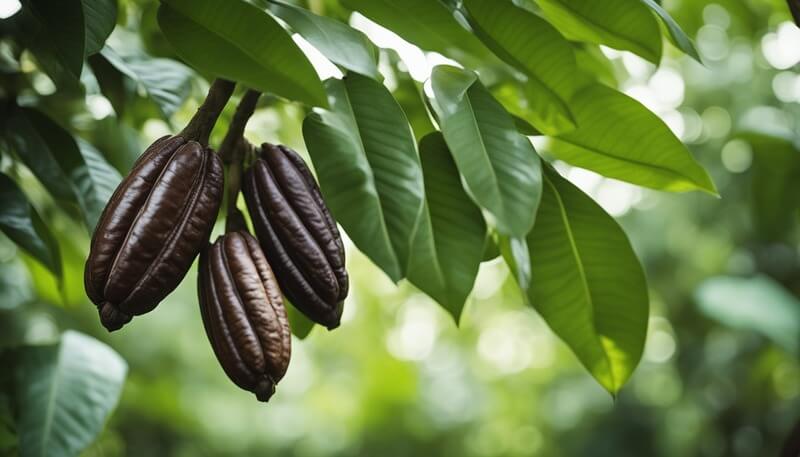
Cacao and cocoa have significant health impacts. Each offers its benefits and risks. People should pay attention to how much they consume to make the most of these products without harming their health.
Positive Effects and Potential Risks
Cacao and cocoa both contain a wealth of beneficial compounds.
Cacao is rich in antioxidants, which help fight disease. It also includes high levels of flavonoids, which benefit heart health by improving blood flow and reducing blood pressure.
Dark chocolate made from cacao is heart-protective and lowers bad cholesterol.
Magnesium in cacao improves muscle function and supports the nervous system. Amino acids present in cacao enhance mood.
Cocoa, while also beneficial, undergoes more processing. This reduces some nutritional value but makes it easier to incorporate into recipes.
Potential risks come from overconsumption.
Both cacao and cocoa are high in calories. Milk chocolate often contains added sugar and fats. High intake can lead to weight gain and increased risk of diabetes.
Appropriate Consumption and Considerations
When including cacao or cocoa in a diet, focusing on appropriate consumption is essential.
Dark chocolate with high cacao content (70% or more) provides the most benefits. A small daily amount (1–2 ounces) can be beneficial without adding too many calories.
Cacao powder is great for smoothies or baking. Look for products with minimal processing to retain more antioxidants.
For magnesium and disease-fighting benefits, choose raw cacao products.
Considerations for choosing between cacao and cocoa depend on dietary needs.
Cacao might be preferred by those seeking maximum nutrients. However, cocoa could be better for those focusing on taste and ease of use.
Cultural and Historical Significance
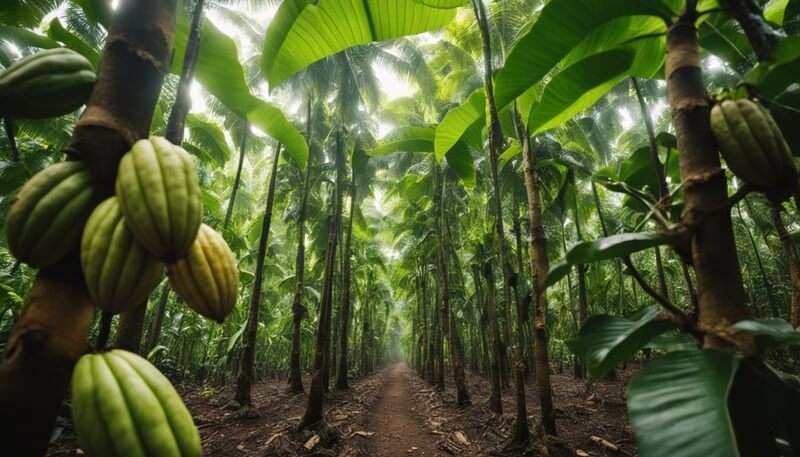
The history of cacao is rich and fascinating. The Theobroma cacao tree, known as the “food of the gods,” was first used by the Olmecs around 2000 B.C.E.
Cacao played a crucial role in the Mayan and Aztec civilizations. They fermented the beans to create a frothy, bitter drink called “xocolatl.” This beverage was often consumed during religious ceremonies and believed to have stimulating properties.
Related: What is a cacao ceremony
Spanish explorers, including Cortés, brought cacao back to Europe. He reported the cultural significance of this drink to King Charles I of Spain. This introduction marked the beginning of chocolate’s popularity in Europe.
The Spanish initially kept the methods of preparing cacao secret to maintain control over its production.
Raw cacao contains high levels of tryptophan, linked to the release of serotonin, a neurotransmitter that promotes well-being.
Cultural Practices:
- Mayans: Cacao was used in rituals and as a form of currency.
- Aztecs: They valued cacao beans so highly that they were used in trade and tributes.
- Europeans: Adapted the beverage to suit their tastes, eventually creating the sweetened version of chocolate known today.
Historical Relevance:
- Cacao was integral to daily life and religion in Mesoamerica.
- The introduction of cacao to Europe significantly changed global consumption patterns of sweets and drinks.
Market and Consumer Trends

Cacao and cocoa have seen evolving market trends and consumer preferences, influenced by global trade dynamics and the rising demand for natural and organic products.
Global Trade and Economy
The global market for cocoa and chocolate is projected to grow significantly. It was valued at USD 46.61 billion in 2021 and is expected to reach USD 67.88 billion by 2029. This growth is driven by increasing demand in the food and beverage sector.
Countries like the United States, Germany, and Switzerland dominate the consumption of cocoa products.
Despite the positive market outlook, challenges such as political and economic unrest are affecting production in major cocoa-producing countries.
Sustainability practices are becoming more important in global trade.
Voluntary sustainability standards help improve market resilience. The shift towards ethical sourcing is noticeable as companies invest in fair trade and environmentally friendly practices.
Consumer Preferences and Demand
Consumer demand for cacao and cocoa products is also changing.
There is a notable rise in the popularity of organic and natural cocoa products, particularly in premium markets.
Products like candied cacao nibs and cacao fruit are gaining traction among health-conscious buyers.
The vegan trend has influenced the cocoa market, with more consumers seeking dairy-free and plant-based chocolate options.
This shift aligns with the broader trend of consumers looking for superfood products that offer health benefits.
Stores now stock various cocoa products ranging from traditional chocolate bars to liquid forms and health supplements.
Increased awareness about cocoa’s benefits, such as its rich antioxidant content, drives the demand for these diverse products.
Frequently Asked Questions
Comparing cacao and cocoa involves understanding their differences in flavor, health benefits, and processing methods.
1. What are the differences between cacao and cocoa?
Cacao is made from raw, unroasted beans, while cocoa is made from roasted beans.
Cacao tends to have a stronger, more bitter flavor than cocoa, which is milder and slightly sweeter.
2. Which is healthier, cacao or cocoa?
Cacao generally has more nutrients than cocoa. Due to less processing, it is richer in antioxidants, magnesium, and iron.
Cocoa still retains some health benefits but loses some nutritional value through processing.
3. Is 100% cocoa the same as cacao?
No, 100% cocoa is not the same as cacao.
While both originate from the same beans, 100% cocoa is made from beans that have been roasted and processed, whereas cacao is minimally processed and unroasted.
4. Is cacao just dark chocolate?
Cacao is not the same as dark chocolate.
Cacao refers to raw or minimally processed beans, whereas dark chocolate is made from processed cocoa and often contains added sugars and fats.
5. Can I substitute cacao for cocoa?
Yes, cacao can be substituted for cocoa in recipes.
However, its more intense and bitter flavor may change the taste of the final product. Adjust sweetness and other flavors as needed.
6. Is there a difference in flavor between cacao and cocoa powders?
Yes, there is a difference in flavor.
Cacao powder has a more intense and bitter chocolate flavor, while cocoa powder is milder and sweeter, making it a preferred choice for many dessert recipes.
7. How does the processing of cacao differ from cocoa?
Cacao is made from fermented, dried, and unroasted beans.
Cocoa undergoes additional steps, including roasting and sometimes alkalizing, which alters the flavor and reduces bitterness.
8. How does the different processing of cacao and cocoa affect their nutritional content?
The more intensive processing of cocoa reduces its levels of antioxidants and other nutrients.
On the other hand, cacao retains more of its natural nutrients, making it a more nutrient-dense option.
This difference is significant when considering their health benefits.

